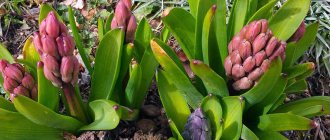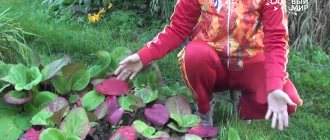Canna is an ornamental perennial that belongs to the family Cannaceae. The first flowers were exported from India, China, South and Central America. It was brought to the European continent by Portuguese ships in the 16th century. The ancient Greek designation can be translated as “reed”, the Latin - “pipe”. An ancient Indian legend tells that the leader of one of the tribes decided to burn the peace treaty in a fire, and a bloody massacre broke out. At the site of the fire, flowers with bloody petals grew, reminiscent of flashes of flame or spilled blood.
Description of the plant
The canna flower belongs to the Cannaceae family and includes several dozen plant species found in the tropical regions of North America, South America, and Asia. A typical species is the Indian eland (Canna indica). In home gardens, mainly numerous, more decorative hybrids are cultivated.
Garden canna (Canna x generalis), known simply as canna, is characterized by ovate-lanceolate leaves mounted on stiff, hollow stems ending in an inflorescence. This is an extremely original perennial plant - grown for its decorative and exotic leaves and bright flowers that decorate the garden from July until the first frost.
The plant produces beautiful, very original flowers that have an asymmetrical structure and form a characteristic panicle inflorescence. Flowers are often very intensely colored:
- red,
- orange,
- pink,
- yellow.
Currently, there are unique varieties with shades of salmon or apricot, and two-tone varieties with contrasting colors are popular. The decorative effect is added by the stamens protruding from the petals.
Cannas can grow up to 2 meters, the height of the plant depends on the variety.
The canna rhizome contains a lot of starch; American tribes ate it baked.
How to buy canna flower seeds on Aliexpress: catalog, price, photo
Canna seeds can also be bought on Aliexpress. If you haven't shopped on this site yet, read our article on how to do so. Or use the reminder of this Chinese online bazaar.
The Cannes catalog can be found at this link. In the Seed Story store you can buy the seeds of a very beautiful red canna. This not very tall flowering plant will decorate even the smallest garden plot.
red canna
If you are looking for Indian yellow canna seeds, look no further than Treasuremountain Garden Store. This Saka Siri canna with variegated petals is sure to attract the attention of visitors to your garden.
Variegated eland
You can also decorate your garden with this scarlet canna. Its main difference is the interesting purple hue of the leaves.
And for home floriculture, you can choose this white canna. It can also be used for container gardening.
White canna
Interesting varieties
There are numerous varieties of cannas, differing in size, color of flowers, leaves - large-flowered and less spectacular, small-flowered.
Grouping varieties by color of flowers and leaves
| Color of flowers, leaves | Varieties | Photo |
| With red flowers |
| President |
| With pink flowers |
| Pink Harmony |
| With red-crimson flowers | Crozi Livadia | Livadia |
| With yellow flowers |
| Eureka |
| With orange flowers |
| Orange Beauty |
| With white flowers |
| Ermine |
| Combined, multi-color |
| Canna Cleopatra (photo) |
| with brown-yellow leaves | Durban | Durban |
| green leaves with light stripes | Yellow Bangkok | Yellow Bangkok |
Landing site requirements
The rhizome from which the shoots grow is the main supplier of nutrients and planting material, and should produce more baby rhizomes - they will produce flowering plants next season. As the old rhizomes die off and new ones are not formed enough, it may happen that the canna will not bloom next season.
To grow beautiful cannas in open ground, it is important to provide optimal conditions for care and development - only well-watered and fertilized specimens are capable of producing thick rhizomes, from which new plants will grow next year.
The requirements for the position and place of planting canna in the garden are as follows:
- sunny, warm position;
- solitary position;
- fertile, humus, constantly moist soil with a pH of 6.5-7.0;
- A good step is to fertilize the soil with rotted manure or compost before planting in the fall or spring.
Requirements for planting in a pot:
- the pots intended for planting must be large enough to allow the rhizome to grow freely;
- it is necessary to place good drainage in the pot, which will protect the rhizome from rotting;
- The plant needs fertile, humus, permeable soil.
Advice. Cannas growing in pots may fall over, so they should be planted in large, wide-bottomed containers with additional rocks. Cannes in containers should have consistently moist soil.
Is it possible to grow cannas indoors or outdoors in a pot?
Cannas can be successfully grown indoors all year round, of course, if you can provide them with long daylight hours (in other words, you should have a bright southern window sill or loggia, or the possibility of additional lighting), and arrange a short dormant period in winter.
And of course, the variety must be low-growing.
Naturally, the pot must be large enough. Moreover, the larger it is, the better your tropical flowers will grow and bloom (and it is better to take a wider one than a deep one).
Important! The pot must have drainage holes from which excess moisture will flow freely. In this case, you can even pour a drainage layer of expanded clay on the bottom (literally 2-3 cm).
Of course, in the summer you can take the pot outside, it will be even better (more light).
Just don’t forget to bring the pot in from outside with the beginning of autumn and cold weather.
In winter, the canna will not bloom, but the decorative appearance of the leaves will not go away.
Landing
The canna plant requires a very long growing season.
In open ground
To speed up flowering and so that the flower can form thick rhizomes, improving flowering next year, it is worth planting the plants in containers already at the turn of February-March.
The rhizomes are planted in a fertile, humus-rich, permeable substrate, providing warmth in the room (15-18 degrees C).
After the leaves appear, the temperature is increased to 20 degrees Celsius during the day and 12-15 degrees at night; sufficient light must be provided.
Before planting cannas in a permanent place, they should be hardened off. It is important to respect the timing of when to plant cannas. Planting in the ground is carried out after May 15, when there is no danger of frost.
Distances must be maintained:
- 30 × 50 cm – for low grades;
- 60 × 90 cm – for tall ones.
The rhizomes are placed horizontally in the holes, and a layer of earth 5 cm thick is poured over it.
In the pot
From rhizomes that look like in the photo below in March, you can grow a beautifully blooming canna at home.
How to plant cannas in a pot - step by step:
- The rhizome has already developed sprouts and roots, so there will be no problems with rooting.
- To achieve the ideal goal, choose a pot of a size so that the rhizomes fit into it. Fill the pot halfway with peat soil.
- Place the rhizome in the pot and cover it with soil.
- After about 3 weeks, you can start to see how quickly the kana grows.
- This is what the root system looks like 5 weeks after planting.
Attention! Immediately after planting the canna, water should be poured very sparingly so as not to flood the plant. It should be remembered that at the initial stage the rhizome does not have fully developed roots, so it cannot absorb excessive amounts of water and may rot. It is enough to keep the substrate slightly moist.
At this stage of rooting, the plant does not need light. Temperature is important. The higher the temperature, the faster the development. The optimal temperature for rooting canna in a pot is 18-22 ° C.
When to plant canna flower tubers and seedlings in spring?
Cannas propagated in this way are planted in mid-May. At the same time, a month before planting flowers, you need to prepare the soil. To do this, humus, phosphorus and nitrogen fertilizers are added to the planting sites of this flower.
The seedlings are planted in deep holes (0.5 meters). There should be about 60 cm between them. 1 cm of manure should be added to each hole. Which must be sprinkled with earth on top (25 cm). The canna rhizome goes deep into the soil to a depth of 7 cm.
Canna tubers
Features of cultivation
The plant is unpretentious in cultivation, loves fertile soils and watering, and requires special wintering conditions. To prolong the flowering of canna, faded inflorescences should be removed.
Watering
Growing canna in the garden involves systematic watering. Producing large amounts of greenery requires a constantly moist substrate, so it is important to water mature plants regularly. In too dry soil, plants will not reach a satisfactory size and may not bloom. Water frequently:
- 2-3 times a week in open ground;
- 4-5 times a week when grown in a pot.
Fertilizer feeding
Caring for cannas includes systematic fertilization - every 2 weeks you need to apply fertilizer for flowering plants.
Wintering tubers
Cannes in our climate are not frost-resistant. To enjoy the flower for more than one season, you need to dig up the rhizomes and store them in winter in a place not exposed to frost.
Preparation for wintering and storage of tubers includes the following procedures:
- The tubers are dug up, the above-ground part is cut off at a height of 10-15 cm;
- the rhizomes are slightly torn off the ground, dried and stored in the basement - on shelves or in containers, covered with damp peat;
- during the dormant period, the room where the rhizomes are stored must be maintained at 5-8 degrees C;
- In winter, it is worth inspecting the tubers several times - in case of any damage, infected rhizomes are immediately removed and thrown away.
Cannas tolerate a temporary drop in ambient temperature below 0 degrees C. It is important not to miss the deadline when digging up the canna - the procedure is carried out after the first autumn frosts in two ways:
- When the first frost catches the leaves, cut them off with a sharp knife at a height of 10-15 cm from the ground. Using a large shovel or pitchfork, carefully dig out the root ball.
- First, we dig up the entire plant, then cut off the stem with a sharp knife.
If we have a small number of plants, the second method is more convenient and faster - the truncated rhizomes do not become contaminated. The first method is useful where there is not enough space for a large number of cut leaves.
If it is not possible to maintain the required temperatures, in order to keep the plant tubers in good condition throughout the winter, you need to frequently ventilate the room. To prevent the roots from becoming too dry, it is worth covering them with damp peat or a layer of sawdust.
Canna garden care
After planting and the beginning of flowering, Cannes need to constantly care for the flowers. When the greatest activity occurs, it is necessary to fertilize the plant three times with minerals and constantly plow the soil. Constant but moderate watering of the plants until the first shoots emerge.
When the plant blooms, it is necessary to water it more, but the main thing here is not to overdo it, excessive moisture can lead to the death of the plant.
To get rid of insects, use insecticides. Dry branches must be cut off in a timely manner and weeds removed. At the end of the growing season, it is necessary to thoroughly loosen the soil to protect the roots from freezing.
Reproduction
Cannes are propagated in several ways:
- vegetative - dividing the bush;
- generative - seeds
Reproduction by dividing the underground part
Canna reproduces most easily by dividing the rhizome into smaller fragments with at least 1-2 buds. The plant is propagated in this way in the spring, before planting. The tubers are dug out from the substrate, washed from the soil, the wounds are dried, and sprinkled with charcoal.
Propagation by seeds
When deciding on generative propagation (seed sowing), it should be remembered that the resulting seedlings will not exactly replicate the characteristics of the mother plant.
The seeds should be soaked in warm water for about 24 hours before sowing, then sown in permeable soil, ensuring a temperature of about 21°C.
Photo. Germinating canna seeds
Seeds that have been previously germinated are planted separately in small containers. If you have several seeds, you can plant them directly in pots with a cross section of 7x7 cm, and when the roots outgrow the pot, we transplant them again into pots twice as large - 14x14 cm.
Seedlings need to be cared for throughout the summer to ensure beautiful flowers next year, the size and color of which cannot be completely predicted. If the seeds are sown in early January, there is a high probability of getting flowering plants this year.
This is interesting! The seeds are so heavy that they were previously used as weapons or as beads to make jewelry.
Collecting seeds
First of all, with this method of canna propagation, it is worth knowing that varietal characteristics are not preserved in subsequent plants obtained in this way. If this does not stop you, then start collecting seeds.
Not all varieties of cannas produce seed pods, and on some of them they may appear, but rarely. This is a feature of certain types, so it is better to read more about them in advance on the label when purchasing.
It is imperative to wait until the seed pods ripen. But since these flowers are capable of growing until late autumn, it is impossible for them to experience even the lightest first frosts. Therefore, inspect them; inside there should be seeds of a rich dark color. If they have not yet ripened, and frost is approaching, then it is better to cut off the boxes and leave them to ripen in a dry, warm place at home.
Diseases and pests
Cannas usually do not suffer from serious diseases. Although they can be affected by some diseases:
- viral diseases are signs of damage: plants do not bloom, do not have bright spots on the leaves, various types of deformations are observed;
- fungal (for example, rust);
- bacterial (canna bacteriosis).
The development of viral diseases is facilitated by unfavorable stressful growing and care conditions:
- strong sunlight,
- quick location change,
- high humidity,
- soil is too wet.
The plant can be affected by pests:
- aphids,
- snails and slugs,
- wireworms,
- nematodes.
Slugs are easy to catch in the evening, using beer traps; you can read more in the article on how to get rid of slugs. The presence of pests can be indicated by traces of dried mucus and round eggs in cracks in the ground and secluded places.
Aphids are destroyed with chemicals; a drug called Confidor 200 SL in a 0.04% concentration is suitable, that is: 4 ml per 10 liters of water.
Why doesn't canna bloom?
The reasons are different, usually it is a violation of planting dates and care features.
- If the plant planted in May was too small and had little time to grow well, then there will be no flowers this year.
- This flower from South America and Mexico needs a long growing season and plenty of warmth. If the summer is cold, flowering may not occur.
- If the rhizomes were planted in a too shady place, this will limit the development of the plants.
Use in landscape design
Usually flowers are planted in numerous groups to show off the maximum beauty of the flower. Cannes look good in various compositions:
- near the pond;
- against the backdrop of a lawn;
- as an element of the discount;
- in a composition in a flowerbed;
- used for planting in pots, containers on terraces, balconies - varieties are planted whose height does not exceed 60 cm;
- the plant is often an element of urban greenery.
Canna is one of the most popular flowering plants in the garden. Its intensely colored flowers are a very interesting element of every flower bed. The unusual shape and bright color make the plants a little exotic. Knowing how to care for cannas, it is easy to achieve beautiful blooming of huge flowers in your garden.
Transplantation from open ground
Almost all of the presented varieties tolerate open ground well, so in winter they can be grown at home, and in the warm season they can be transplanted into flower beds or installed in an artificial reservoir on the site. When transplanting a plant into a pot, do not choose a container that is too large, otherwise when watering there will be a high risk that the roots will rot from excess moisture.
Here it is important to take into account the fact that every year with each subsequent transplant it is necessary to select a larger pot, since this culture develops very quickly. Provided there is high-quality watering, it will tolerate transplanting from open ground into pots very well.
You can learn on your own in your apartment how to grow cannas from tubers or seeds. We have devoted a separate article to reproduction.











